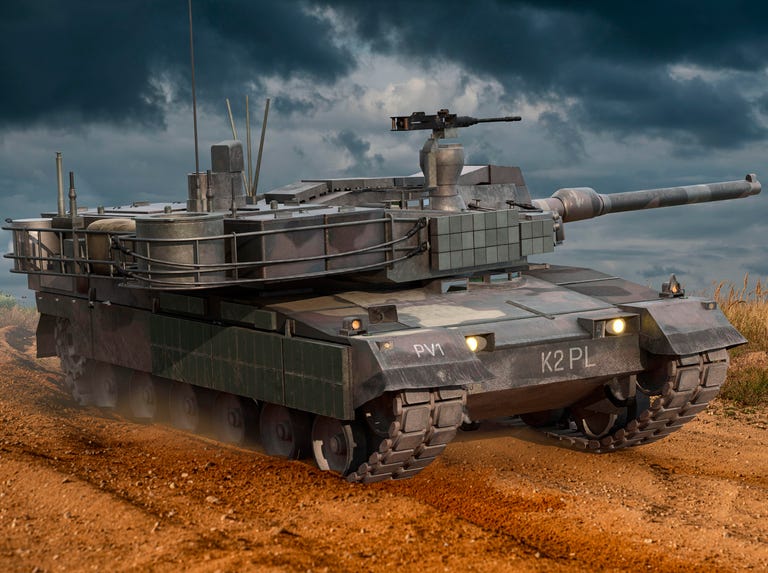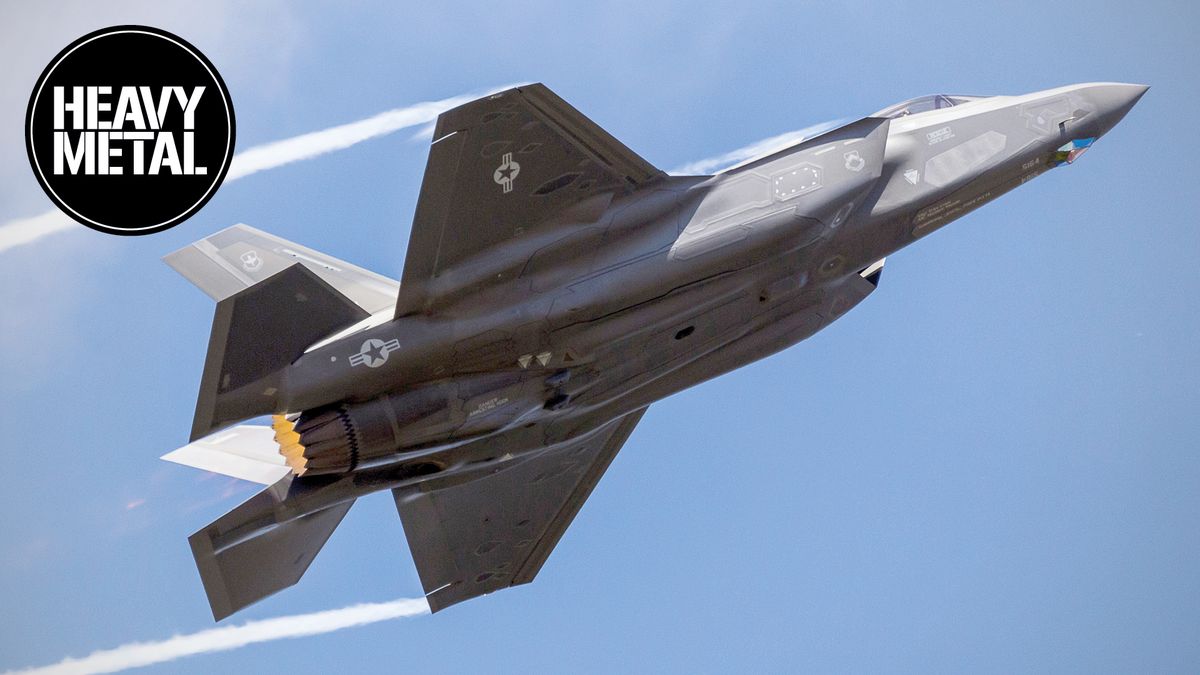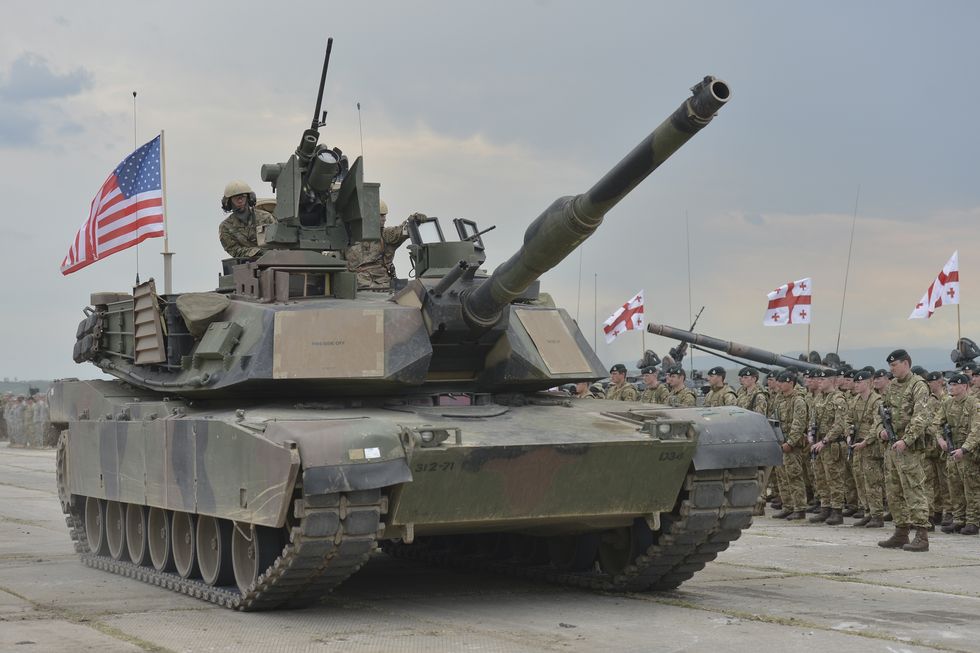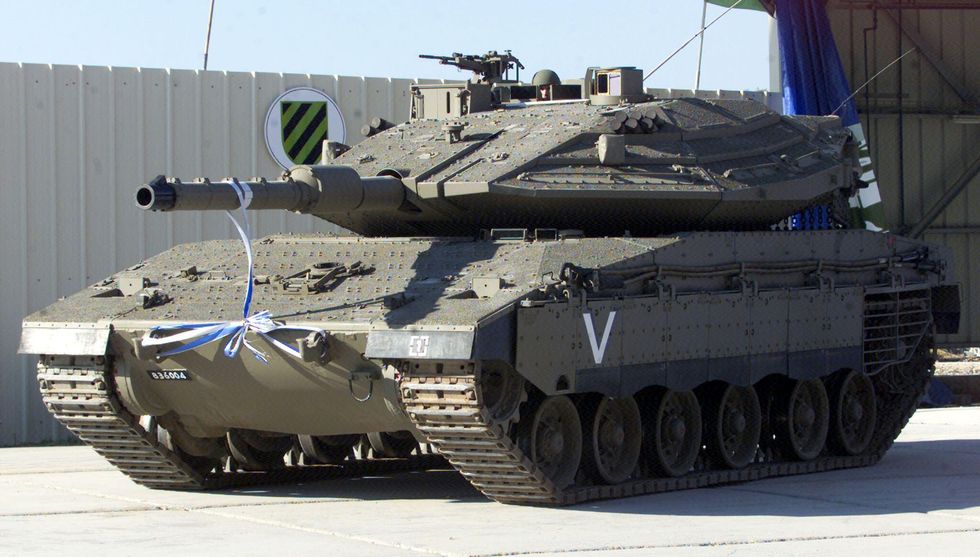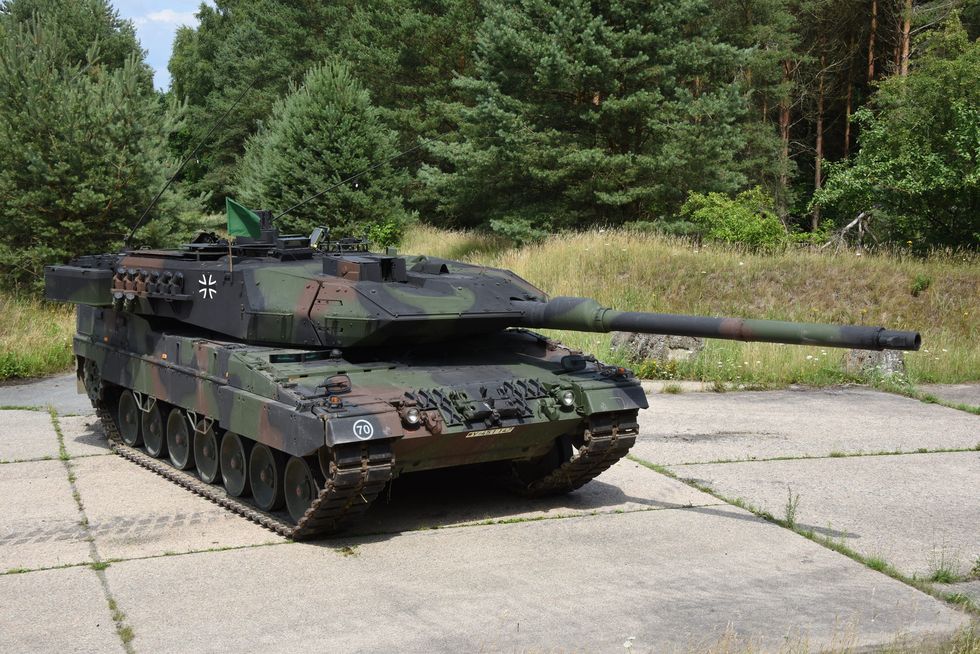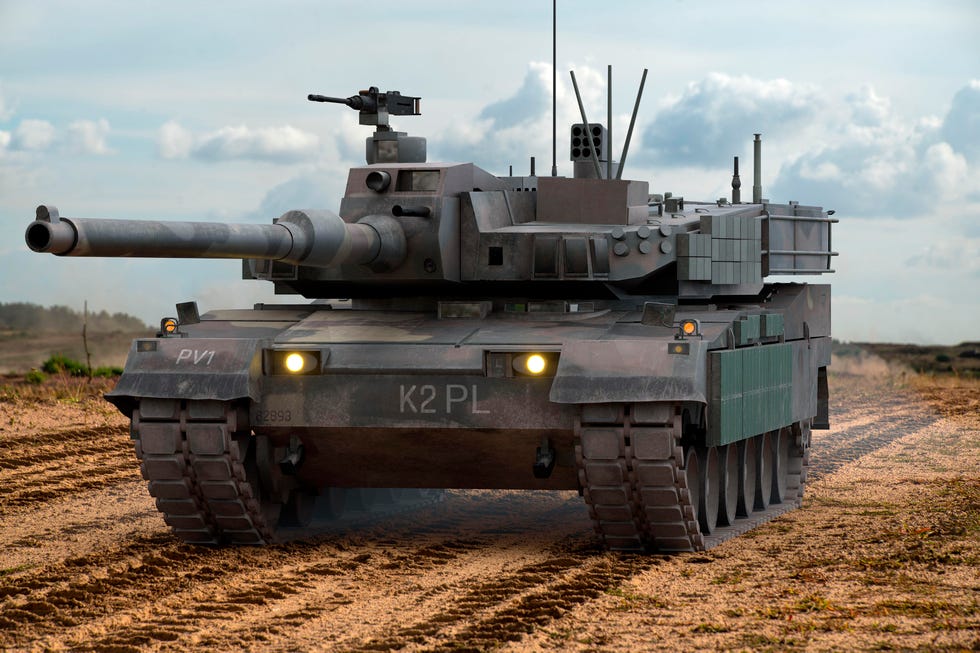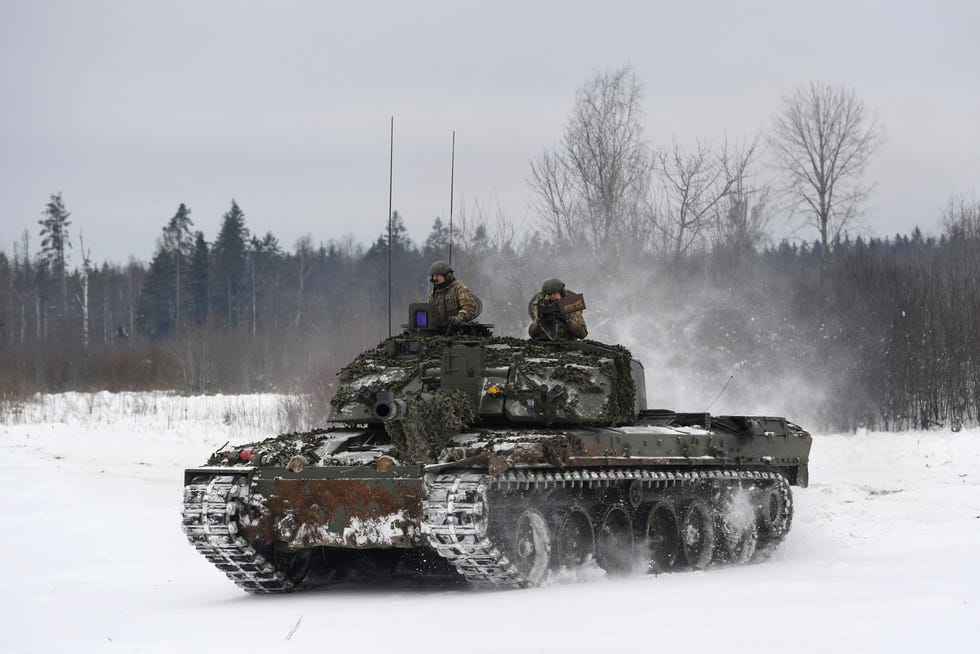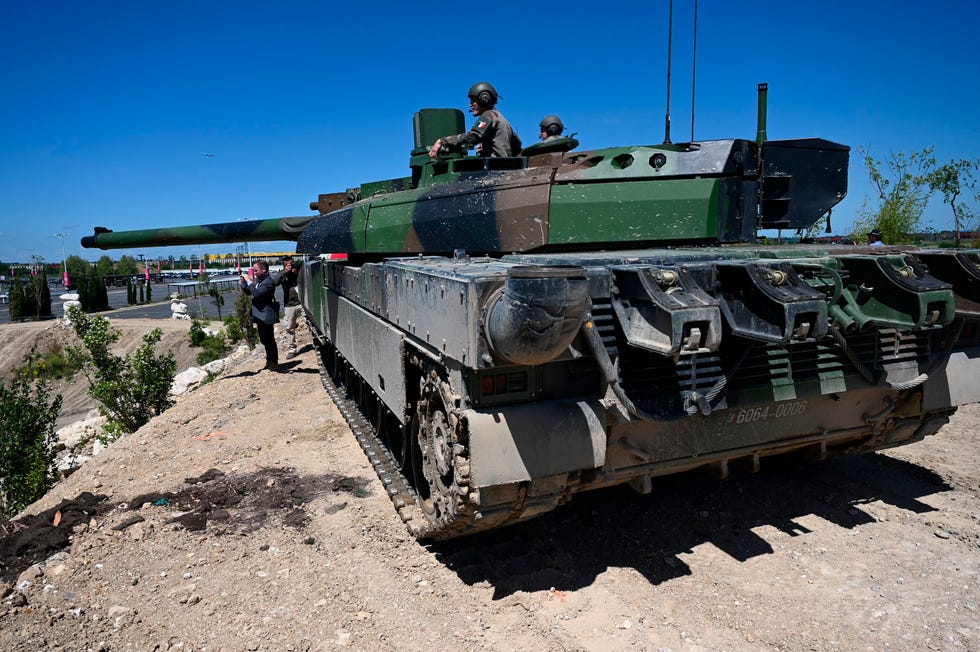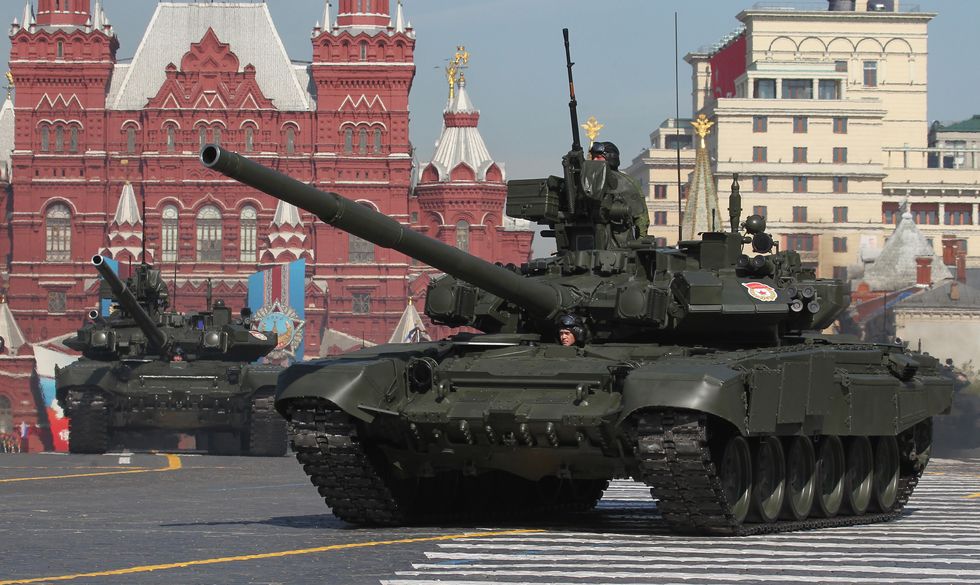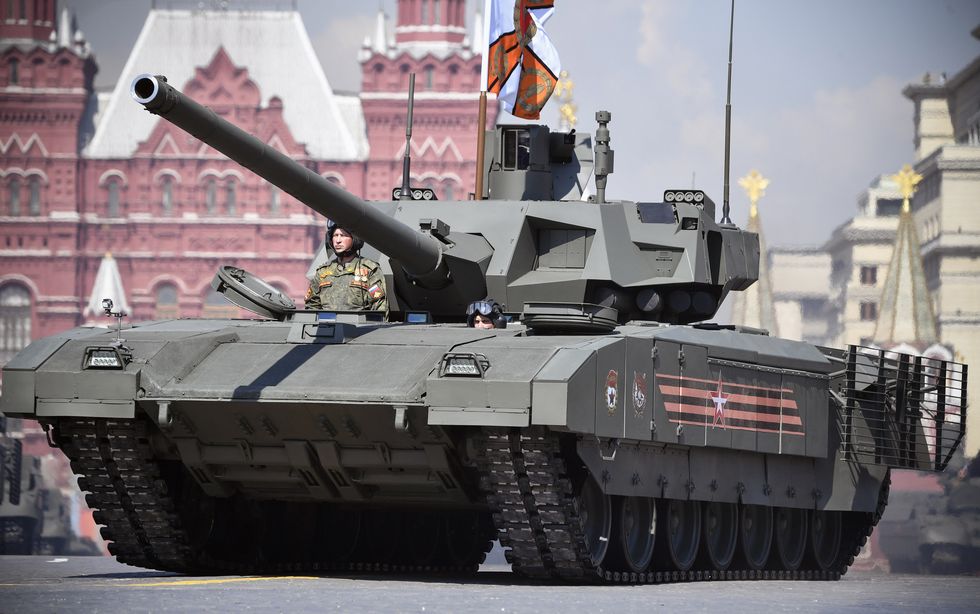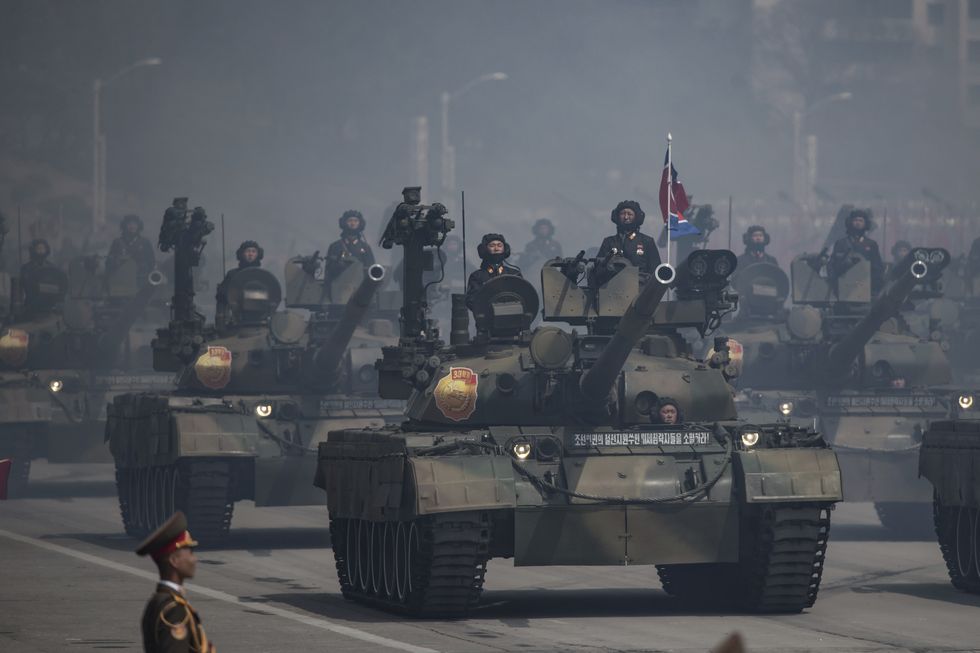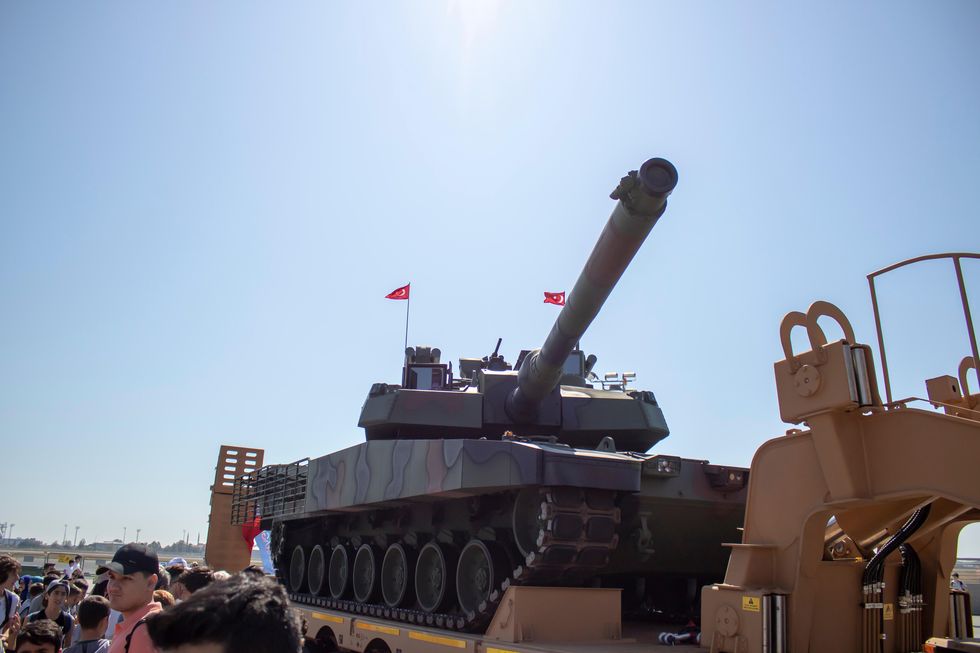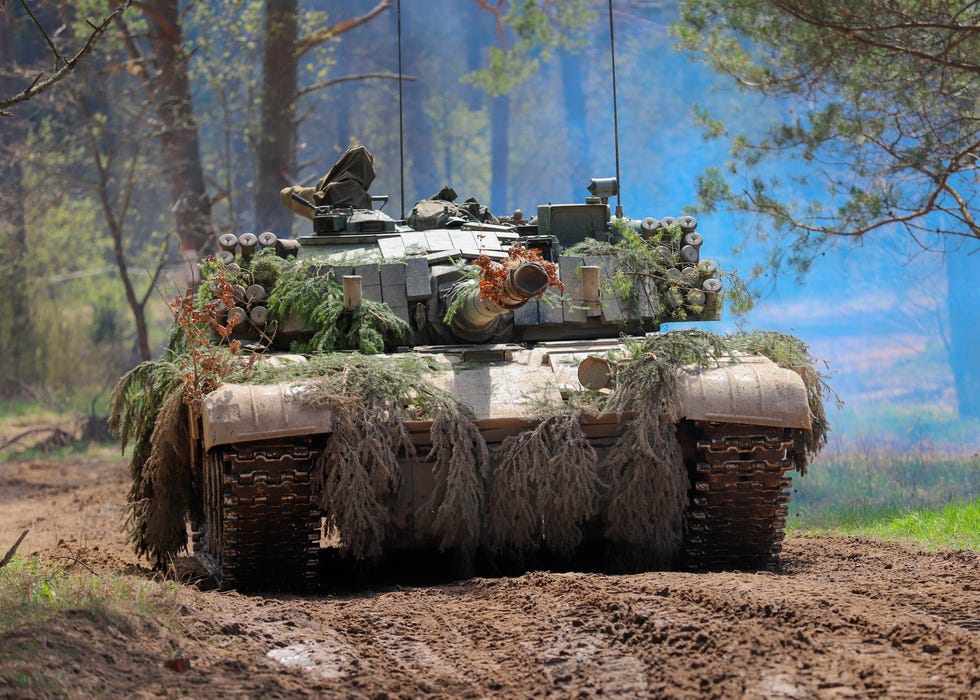Germany shocked life into the future of battle tanks when it released details of its new KF51 Panther this summer. Painted in green, yellow, and gray digital camo, the tank has a sleek hull and an imposing turret. But its most exciting features are unseen: high-tech active armor that explodes just prior to being struck, directing munitions away from the tank; the potential to support AI-powered weapons; its own drones that it can release to electronically jam enemy radars; and remote-controlled lasers that will fire at enemies without the tank crew having to leave the armored hull.
This sophisticated battlefield vehicle might not see action for another decade, but some of those technologies are already appearing on tanks from Russia, China, Turkey, and the United States as armies rally to modernize tanks to defend against increasingly effective anti-tank weapons. The battlefields of Ukraine clearly reveal the devastation of those technologies. Ukraine’s army has destroyed as many as 936 of Russia’s aging T-72 and T-80 tanks. Images of exploded and burned hulls serve notice that armored fighting vehicles are no longer the impenetrable fortresses they were when they dominated World Wars I and II.
Despite Russia’s heavy tank losses in Ukraine, experts expect its newest and most sophisticated tank to roll out as soon as this year with new technologies and weapons systems that might rival those of Germany’s Panther. Many of those updates reflect the changing role of main battle tanks—a designation for the heavily armored, fast, powerful, do-it-all battlefield vehicles. No longer a devastating attack weapon, modern tanks, analysts say, are taking on vital but more limited battlefield roles supporting infantry forces on the front lines.
In the journal Military Review, Institute for Defense Analyses scholars Alec Wahlman and Col. Brian M. Drinkwine (Ret.) contrast the disastrous 1993 Battle of Mogadishu, made infamous in the 2001 film Black Hawk Down, with the successful U.S. invasion of Baghdad in 2003. In Baghdad, tanks carried soldiers and Marines into the city; in Somalia, only aircraft and tactical vehicles accompanied infantry troops, and the troops took heavy casualties.
“Lack of even a modest U.S. armor presence in Somalia hobbled mission efforts,” Wahlman and Drinkwine wrote. “In stark contrast, the rapid seizure of Baghdad and quick defeat of organized Iraqi forces at the outset of Operation Iraqi Freedom in 2003 were largely the result of Iraqi inability to effectively counter highly mobile heavy armor in an urban environment.”
As long as a human soldier fights on a field, along a muddy road, or on foot in a town or village, the battle tank will likely also be there, providing essential cover.
“When you need a tank, you need a tank,” says Maj. Adam Link, a former Marine tank officer. “There’s nothing really that can replace it on the battlefield.”
So even as militaries prioritize air power and technological warfare systems, the armored tank remains a critical weapon, and countries are scrambling to update aging designs. The following 16 models are the most advanced, powerful, and important heavily armored vehicles in the world.
U.S.: M1A2 Abrams SEPv3
Year introduced: 2020 | Crew: Four | Weight: 73.6 tons | Cost: $6.2 million
Dating from 1980, the M1 Abrams tank family lacks some of the flashy features built into tanks of the twenty-first century. But its rugged, reliable General Dynamics Land Systems engineering and consistent upgrades have kept it dominant in every conflict it has faced. Abrams tanks crippled Iraqi armored formations in the 1991 Battle of 73 Easting, considered the last great tank showdown of the twentieth century. In just 23 minutes, nine American M1A1 Abrams tanks destroyed 50 Iraqi T-72 tanks and dozens more armored vehicles using their long-range firing capabilities to wreak havoc without taking a single casualty. Abrams tanks also shored up infantry formations during the 2003 assault on Baghdad, and supported patrols to a lesser extent in Afghanistan. Each successive version of the M1 has received additional armor, with the M1A2 SEPv3, introduced in 2020, weighing 13 tons more than the original due to these upgrades.
The newest variant features a turret-mounted, low-profile, common-remote-operated weapons station (LP CROWS) that captures video by day and thermal imaging by night, with automatic target tracking and a laser range finder. The 120mm smoothbore M256 main gun now fires an advanced multipurpose round, developed over 15 years to replace four separate tank munitions. The round can be dispatched to bust a bunker or breach a wall to clear the way for ground troops; or in airburst mode, it can take out anti-tank guided missile teams from as far as 2,000 meters away. As of 2021, all Abrams tanks also feature the same Trophy Active Protection System introduced on the Israeli Merkava Mark IV.
Israel: Merkava Mark IV
Year introduced: 2004 | Crew: Four, plus six passengers | Weight: 71 tons | Cost: $4.5 million
Merkava means “chariot,” an appropriate name for a tank designed to carry extra passengers and packed with features to ensure their survival. The Merkava family of tanks emerged not long after 1973’s Yom Kippur War and was used in the 1982 Lebanon War and a half dozen conflicts since. The Merkava Mark IV, introduced in 2004, has a unique design that mounts the engine near the front of the vehicle, creating space for up to eight passengers in addition to the crew of four. While dated, the Israeli tank remains viable thanks to its Trophy Active Protection System; the countermeasures shield is still best-in-class technology and was first used on the Merkava IV. Trophy works by using vehicle-mounted radars to track and classify incoming projectiles. When an enemy missile is identified, the tank fires small explosive projectiles that destroy the munition without damaging the tank itself. Trophy proved effective in its very first combat test in 2011, when a Merkava equipped with the system neutralized a rocket-propelled grenade fired by Palestinian troops from Gaza. Even more tech breakthroughs may be ahead for the Merkava: In 2018, the Israel Defense Forces announced plans for the Merkava Mark IV Barak, a first-of-its-kind “smart tank” upgrade that uses sensors and AI to take over such mundane crew tasks as navigating around obstacles and scanning for threats. The tank maker is also developing an “Iron View” virtual-reality helmet that will allow crew members to see beyond the hull for a 360-degree view of the battlefield.
Japan: Type 10
Year introduced: 2012 | Crew: Three | Weight: 48 tons, fully loaded | Cost: $9 million+
Japan’s Type 10 is widely considered the world’s first fourth-generation tank, which means it boasts some of the early iterations of the advanced weapons we’ll see on future tanks like the Panther. Engineered by Japan’s Technical Research and Development Institute over 10 years, the Type 10 is light without sacrificing armor or firepower. At just 48 tons at its heaviest configuration—compare that with the M1 Abrams at 73 tons—the body of the Type 10 features modular ceramic armor that can be added or removed in segments to deliver protection where it’s needed most. The hull and turret are made with nanocrystal steel shot through with carbon nodules, which makes the metal exceptionally light and strong. The 120mm L/44 smoothbore gun is incredibly accurate, thanks to a laser range finder and a fire-control system that can automatically track, identify, and classify targets. The tank’s active hydropneumatic suspension system (a technology invented by the automaker Citroën for its sports cars) smooths the ride, making it easier for crews to aim the gun while on the move. During an impressive demonstration of the technology shown in a video posted on YouTube in 2015, a Japanese officer sets two glasses next to the barrel of the tank’s main gun and fills them with wine. As the Type 10 pitches up and down and the turret rotates nearly 180 degrees, the shock-absorbing suspension keeps the barrel completely level and the wine glasses spill-free.
Germany: Leopard 2A7
Year introduced: 2014 | Crew: Four | Weight: 71 tons | Cost: $8.8 million+
With more than 3,500 units in operation and used by 19 countries, Germany’s Leopard is one of the most common tanks on the planet. The 2A7+ variant is optimized for urban operations and low-intensity conflict, with added frontal protection and more modular armor to shield against roadside bombs and rocket-propelled grenades. The tank’s popularity reflects a changing battlespace where fighting may take place block to block in densely populated cities. The Leopard fires DM11 high-explosive rounds that can be programmed to detonate on impact, above a target, or on a delay to create more damage. An FLW 200 remote-weapons station offers battlefield surveillance, sniper detection, and the ability for crew members to fire on the enemy from inside the hull, never exposing themselves to danger. Recent upgrades prioritize crew comfort, with compartment cooling systems in the turret and chassis. Earlier versions of the Leopard patrolled Kosovo in 1999 and supported the Canadian military in Afghanistan. While older versions of Leopard 2 have taken heat for their performance in Syria, where ISIS allegedly took out 10 Turkish-operated tanks with guided missiles and improvised explosive devices, the 2A7, with its active protection system and beefed-up armor, has proven much harder to defeat.
Germany: KF51 Panther
Year to be introduced: 2035 (Projected) | Crew: Three | Weight: 65 tons | Cost: Unknown
Still years from production, this powerful new tank from the German armament giant Rheinmetall is generating massive interest in the defense community. Named in honor of the Panther, a WWII-era medium tank, it will replace Germany’s current Leopard 2 and French Leclerc. It’s set to have a huge 130mm main gun, compared with the 120 and 125mm weapons of its most advanced peers. Called the Rheinmetall Future Gun System, the weapon purports to be 50 percent more effective than 120mm systems. It’s also being built to carry HERO 120 loitering munitions, also known as “kamikaze drones,” which can fly in a designated airspace while identifying a target, and then dive into it. Rheinmetall says it will build versions with an optional fourth workstation for a drone operator, and the defense contractor says it’s also developing a fully autonomous version, removing humans from the tank completely.
South Korea: K2 Black Panther
Year introduced: 2014 | Crew: Three | Weight: 61 tons | Cost: $8.5 million+
One of the newest sets of armor on the world stage, the K2 Black Panther might be the most adaptable tank ever made. Its watertight turret and top-mounted snorkel allow it to submerge to depths of more than 12 feet to cross bodies of water. Its advanced “in-arm suspension unit” system allows the crew to raise the chassis up to 16 inches to cover rocky terrain, or angle it to “kneeling” or “sitting” profiles to increase targeting options for the main gun. The suspension gives the CN08 120mm 55-caliber smoothbore gun up to 24 degrees of elevation, enabling it to better target low-flying aircraft, compared to just 20 degrees for the Abrams tank. The K2 sports a combination of classified steel-plate and explosive reactive armor (ERA)—metal panels containing C4 or another plastic explosive that detonate outward when hit by a shaped charge, such as a rocket-propelled grenade. Despite a total weight of just 55 tons, the tank’s armor has reportedly withstood a direct hit from one of its own 120mm tungsten-core sabot rounds in testing.
United Kingdom: Challenger 2
Year introduced: 1997 | Crew: Four | Weight: 62.5 tons | Cost: $4.9 million (1999)
Tank warfare originated when Great Britain introduced the world’s first tank, the Mark 1, at the Battle of the Somme in 1916. So it’s fitting that the U.K. still operates one of the world’s most powerful tanks. In service since 1998 and updated several times since, the Challenger 2 lacks the sophisticated defenses of modern Gen-4 tanks, but its 120mm main gun is well regarded for its accuracy and reliability. Plus, it can carry 50 rounds, versus the M1A2 Abrams’s 42. The original Challenger’s gun earned battle cred in 1991 when it notched a five-kilometer tank-to-tank kill against an Iraqi vehicle—still the longest ever recorded. In addition to Chobham ceramic-composite armor, the Challenger 2’s defenses include a smokescreen generated by shooting diesel into the tank’s exhaust manifold. The thick, choking fumes are intended to obscure the Challenger and any surrounding ground forces while distracting and flustering the enemy.
France: Leclerc Scorpion XLR
Year introduced: 2022 | Crew: Three | Weight: 63 tons | Cost: $4 million+
France’s 1990s-era tank received formidable updates this year. The new Leclerc Scorpion XLR version includes a next-generation counter-IED jammer and GALIX, a passive countermeasures system that hides a vehicle from the enemy by using smart sensors to fire decoys or a 360-degree smoke cloud from 24 vehicle-mounted launchers. The Leclerc boasts exceptional fuel efficiency: Its operational range is more than 340 miles, some 117 miles better than that of the Abrams. Its updated modular armor includes a unique wire-cage configuration on the rear of the hull and chassis that gives the engine additional protection against rocket-propelled grenades—a response to the growing threat from shoulder-fired anti-tank missiles in urban warfare. Its Giat Industries 120mm smoothbore main gun is 6.2 meters long, giving it greater muzzle velocity than the typical 44-caliber guns of its era. The XLR also has a turret-mounted, remote-operated weapons station that lets the crew fire a 7.62mm machine gun from within the tank.
Russia: T-90
Year introduced: 1992 | Crew: Three | Weight: 51 tons | Cost: $4.5 million (2016)
Russia’s T-90 has been criticized for the frequency of its defeats in Ukraine. Based on the Soviet T-72 chassis and upgraded most recently in 2017, it features explosive-reactive armor and a Russian Shtora-1 active protection system that includes a pair of electro-optical/infrared “dazzlers,” which look like glowing red eyes on the front of the turret and can thwart enemy missiles’ targeting systems. But those defenses have failed against Javelin anti-tank missiles in Syria, and even against Carl Gustaf 84mm recoilless rifles in Ukraine. Defense experts say the design, which stores ammunition in the turret, is vulnerable when hit—the ignited ammo can turn the tank into a jack-in-the-box, blowing the turret off. While this flaw demonstrates Russia’s tendency to prioritize firepower over survivability in tank design, the T-90 is not a complete failure. Its low-lying hull makes it hard to hit, and its steel-composite, reactive-blend armor is designed to defeat anti-tank rounds. Plus, its 2A46m 125mm smoothbore gun has become more accurate with successive upgrades. Perhaps most appealing about this workhorse tank is the price: an economical $2.5 to 4.5 million, which allowed Russia to maintain as many as 1,000 T-90s at one point.
Russia: T-14 Armata
Year introduced: 2022 | Crew: Three | Weight: 52 tons | Cost: $4 million
Russia may be losing scores of Soviet-engineered T-72 and T-80 tanks in Ukraine and has reportedly deployed at least a few of its far more advanced T-90M Proryv tanks as well—but the country’s most devastating mobile fortress has yet to hit the battlefield. The T-14 Armata promises next-generation design and deadliness. Its sleek, low-riding hull houses a sophisticated command suite, complete with an unmanned, remote-controlled turret, 360-degree panoramic sight, and automatic fire-control system that can classify and identify targets before a human operator spots them. In addition to its 2A82-1M 125mm smoothbore cannon with autoloader, the Armata reportedly features a new kind of defensive weapon: a 3VD35 protective aerosol “smokescreen” that blocks an enemy’s weapon-guidance systems by reflecting heat and light back at them. The advanced technology and cuts in Russian defense spending, however, seem to be bogging the Armata down. Russia has planned to begin production by 2020, but the tank may not be ready until 2023 or later.
Ukraine: T-84 Oplot-M
Year introduced: 2009 | Crew: Three | Weight: 53 tons | Cost: $5 million
Ukraine’s mightiest tank has barely made an appearance in the country’s war with Russia due to untimely budget shortfalls. Ukraine’s military acquired only 10 of the highly regarded tanks, and it sold four of those to the United States. The Oplot-M, based on the Soviet-designed T-80, has a powerful 1,500-horsepower, six-cylinder diesel engine that gives the tank a top speed of 43 miles per hour. Its Zaslon active protection system, designed to be used alongside explosive-reactive armor, can withstand impacts from incoming missiles traveling at speeds of up to 1,200 meters per second. While Ukraine did not invest substantially in this design, Thailand did, purchasing 49 lightly modified Oplot tanks in 2011.
North Korea: P’okp’ung-Ho
Year introduced: 2002 | Crew: Four | Weight: 44.3 tons | Cost: Unknown
Nearly everything in North Korea’s dictatorship is shrouded in mystery and deception, including information on its tanks. The P’okp’ung-Ho, or Storm Tiger, is formally known in the North as the Chonma-215 or Chonma-216, depending on its main armament. The Chonma-215 fires the same 115mm 2A20 round as the Soviet T-62 tank, while the more modern Chonma-216 has the 125mm 2A46 smoothbore round found on tanks used by more than a dozen other nations. Each model incorporates elements of legacy Soviet T-72 and Chinese Type-85 tanks, apparently reverse-engineered and modified to fit the North Koreans’ requirements. An official foreign weapons assessment by the U.S. Army’s Training and Doctrine Command underscores the uncertainty: While the P’okp’ung-Ho is believed to have been introduced in 2002, it is possible the tank entered service as early as 1992. Likewise, it’s hard to verify how well the tank’s impressive-looking weapons work. It’s unlikely that the North can afford to fire the conventional tungsten-tipped rounds from the Chonma-216’s main gun, and resorting to steel-tipped rounds would leave it unable to breach other world-class tanks. Its secondary weapons, however, pack loads of firepower. Its pair of what analysts believe to be 9K38 Igla surface-to-air missile launchers provides a short-range air defense, something that is extremely unusual for a tank. The turret-mounted machine gun, a KPV 14.5mm weapon designed for anti-aircraft use, gives the tank commander more firepower beyond the conventional 7.62mm coaxial gun.
China: Type 99A
Year introduced: 2011 | Crew: Three | Weight: 64 tons | Cost: $2.6 million
Thanks to a 1,500-horsepower engine and a light, 55-ton body, the Type 99A can reportedly move at nearly 50 miles per hour. This advanced version of China’s first mass-produced modern tank features a distinctive angular turret profile and composite armor that is further enhanced by explosive-reactive side panels. The 99A’s Chinese-made GL5 active protection system can sense incoming anti-tank guided missiles out to 100 meters and neutralize them or knock them off course with 12 mounted launchers. A line-of-sight laser communication system can transmit encrypted messages out to 2.2 miles and also help the crew distinguish between friends and enemies by interpreting their radio frequency emissions. With more than 7,000 tanks in its inventory by some accounts, China is second only to Russia in mechanized power and maintains an estimated 1,200 Type 99s alone.
Turkey: Altay
Year to be introduced: 2023 (Projected) | Crew: Four | Weight: 61 tons | Cost: $13.75 million
When the first Altay rolls off the production line next year, it will represent the first time Turkey has designed and manufactured its own tank since World War II. The vehicle is named for a revered Turkish cavalry commander and comes with some of the most advanced tech and armor on any tank. A Volkan-II fire-control system features electrical gun and turret stabilizers that allow for accurate firing at top speeds; plus, a Turkish-made AKKOR active protection system incorporates an advanced vehicle-mounted radar that can detect incoming threats fast—even at close range—and electronically disrupt their flight pattern or fire explosive countermeasures for tank protection. The chassis is similar to that of South Korea’s K2 Black Panther and fits modular composite armor made by the Turkish company Roketsan. At an estimated $13.8 million apiece, the Altay will be the most expensive tank ever produced. The sophisticated defenses and weapons systems of modern tanks don’t come cheap.
Italy: C1 Ariete
Year introduced: 1995 | Crew: Four | Weight: 59 tons | Cost: $4.9 million
Italy’s only tank is a dated but respectable battlefield weapon. The Ariete, which translates to “battering ram,” sports a 12-cylinder, 1,250-horsepower engine made by the Italian carmaker Fiat-Iveco that enables it to traverse a 60 percent grade—practically a vertical wall. A setup that tank designers call “hunter-killer” gives the commander a panoramic view of surroundings without having to change position or open the turret. Despite having a similar profile and comparable armor to allied tanks like the Abrams, the Ariete is significantly outranged by its NATO counterparts: Its thermal sight is effective to only about 1,500 meters, while the Abrams can hit targets beyond 3,000 and 4,000 meters. But in the 2016 Strong Europe Tank Challenge, hosted by the U.S. and German militaries, an Ariete crew held its own, finishing fourth of seven, ahead of the two Abrams crews.
Poland: PT-91 Twardy
Year introduced: 1995 | Crew: Three | Weight: 50 tons | Cost: $5.9 million
Poland’s aging main battle tank gained new relevance when the country sent an unspecified number of these tanks to Ukraine. It’s likely to be a formidable addition to the aging Soviet T-64s and T-72s Ukraine is already using to defend itself against Russian forces. Introduced in 1995, the Twardy (meaning “hard” or “tough”) is an updated version of the T-72 but features Polish-made ERAWA explosive-reactive armor across the surface of the vehicle, with a double layer of explosive on the hull and turret. It also adds a modern auto-loading mechanism to the 2A46 125mm main gun, which eliminates a crew member and enables faster firing.
